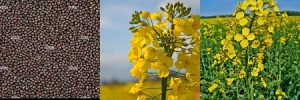Did you know that both, Arabidopsis thaliana and Brassica napus L., have taken center stage in the innovative EpiSeedLink project?
Arabidopsis thaliana and Brassica napus L. are two fascinating members of the Brassicaceae family, with distinctive characteristics and roles in the plant world. Let’s explore their unique features and contributions!

🌿 Arabidopsis thaliana:
Commonly known as “rockcress,” Arabidopsis thaliana is a model plant used extensively in scientific research. Its small size, typically reaching about 10-20 centimeters in height, and short lifecycle of about 6-8 weeks under optimal conditions make it ideal for studying plant genetics, development, and responses to environmental factors. Arabidopsis thaliana serves as a powerful tool in understanding fundamental processes in plants and has contributed significantly to advancements in biotechnology.

🥬 Brassica napus L. (Canola/Rapeseed):
Brassica napus L. is an essential oilseed crop widely cultivated for its high-quality vegetable oil, known as “canola oil.” This versatile crop has diverse applications, from culinary use to industrial purposes, such as biofuel production. Brassica napus L. has a more extended growth cycle compared to Arabidopsis thaliana, around 5-6 months from planting to maturity making it an excellent candidate for studying agricultural practices and crop improvement.

Together, Arabidopsis thaliana and Brassica napus L. are igniting a new era of plant research through the EpiSeedLink project. By delving deep into their genomes and epigenomes, we hope to pave the way for exciting discoveries that will benefit global agriculture and ensure a more sustainable future.
Text by Kingsley Onyinye Ibeabuchi, PhD Student EpiSeedLink Marie Skłodowska-Curie Action
The frontal image about the differences between the two species by Shannon Skye Derman, PhD Student Marie Skłodowska-Curie Action EpiSeedLink

